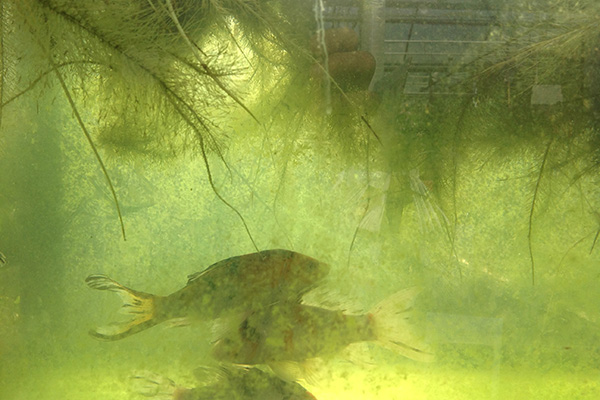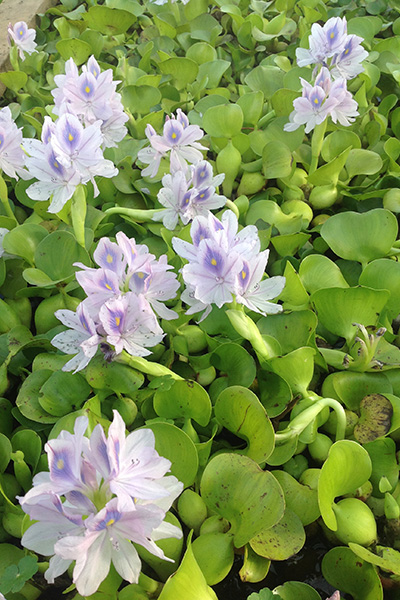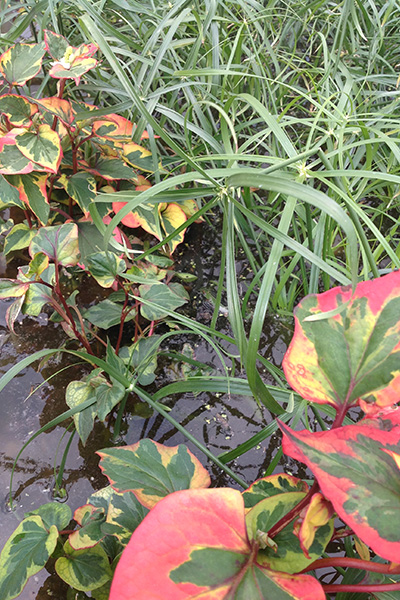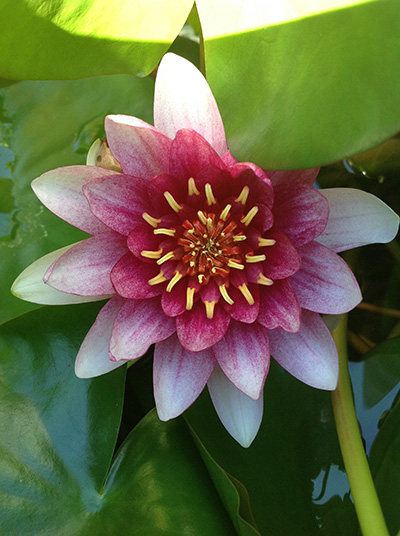Water plants are key ingredients to achieve an ecological balance in your pond.
There are 4 basic groups and each pond should have some of each, resulting in coverage of two thirds of the pond surface with plants in order to naturally create a healthy and clear pond.
 1. OXYGENATORS: These plants absorb carbon dioxide and convert it to beneficial oxygen, as well as providing shelter for small fish. By competing with algae for available nutrients they help to keep your pond water clear. Example of an oxygenator is Hornwort.
1. OXYGENATORS: These plants absorb carbon dioxide and convert it to beneficial oxygen, as well as providing shelter for small fish. By competing with algae for available nutrients they help to keep your pond water clear. Example of an oxygenator is Hornwort.
 2. FLOATERS: These are the easiest to add to your pond, simply drop onto the surface. The floating roots absorb nutrients from the water to compete with algae, as well as providing shade and shelter to pond fish. Floaters offer different textures to the surface of the pond, and some, like the Water Hyacinth provide flowers. The increased surface coverage of the pond reduces the sunlight that contributes to algae growth. Examples of Floaters are Water Hyacinth, Water Lettuce, Fairy Moss and Duckweed. Floaters would require additional light and water temperatures of 21C in order to attempt to winter over.
2. FLOATERS: These are the easiest to add to your pond, simply drop onto the surface. The floating roots absorb nutrients from the water to compete with algae, as well as providing shade and shelter to pond fish. Floaters offer different textures to the surface of the pond, and some, like the Water Hyacinth provide flowers. The increased surface coverage of the pond reduces the sunlight that contributes to algae growth. Examples of Floaters are Water Hyacinth, Water Lettuce, Fairy Moss and Duckweed. Floaters would require additional light and water temperatures of 21C in order to attempt to winter over.
 3. MARGINALS: This group of plants provide color, texture and height to create interest and focal points in the pond, as well as having their roots absorb nutrients to compete with algae growth. Marginals grow in shallow water. Bricks can be added to raise the pots to the desired level near the pond edges, to result in 2-6 inches of water above the soil level. Fertilize during the growing season using Aquatic fertilizer tabs, using 2 or 3 tabs for each 1 or 2 gallon size pots. Hardy marginals will survive the winter if frozen into the ice. Foliage can be trimmed back in Fall or early Spring. Less hardy marginals can be brought indoors for the winter, cutting back foliage and placing in buckets of water in a cool area with indirect light. Add water as needed. Examples of marginals are Acorus, Ajuga, Buttercup, Cattail, Cyperus, Houttounia, Horsetail Rush, Lysmachia, Moneywort, Pennywort, Parrot Feather, Water Celery, Water Mint, Water Iris, Water Alyssum and Taro.
3. MARGINALS: This group of plants provide color, texture and height to create interest and focal points in the pond, as well as having their roots absorb nutrients to compete with algae growth. Marginals grow in shallow water. Bricks can be added to raise the pots to the desired level near the pond edges, to result in 2-6 inches of water above the soil level. Fertilize during the growing season using Aquatic fertilizer tabs, using 2 or 3 tabs for each 1 or 2 gallon size pots. Hardy marginals will survive the winter if frozen into the ice. Foliage can be trimmed back in Fall or early Spring. Less hardy marginals can be brought indoors for the winter, cutting back foliage and placing in buckets of water in a cool area with indirect light. Add water as needed. Examples of marginals are Acorus, Ajuga, Buttercup, Cattail, Cyperus, Houttounia, Horsetail Rush, Lysmachia, Moneywort, Pennywort, Parrot Feather, Water Celery, Water Mint, Water Iris, Water Alyssum and Taro.
 4. WATERLILIES: Lilies provide interesting foliage as well as spectacular flowers while providing shade and shelter for pond fish. These plants also absorb mineral salts and reduce sunlight that algae needs to grow. Plants should be submerged so the soil is covered by 6 to 24 inches of water. For best growth and flowering, fertilize with Aquatic fertilizer tabs, using 2 or 3 tabs per 1 to 2 gallon size pots. Hardy Waterlilies will winter over if they are below the ice level in the pond.
4. WATERLILIES: Lilies provide interesting foliage as well as spectacular flowers while providing shade and shelter for pond fish. These plants also absorb mineral salts and reduce sunlight that algae needs to grow. Plants should be submerged so the soil is covered by 6 to 24 inches of water. For best growth and flowering, fertilize with Aquatic fertilizer tabs, using 2 or 3 tabs per 1 to 2 gallon size pots. Hardy Waterlilies will winter over if they are below the ice level in the pond.
